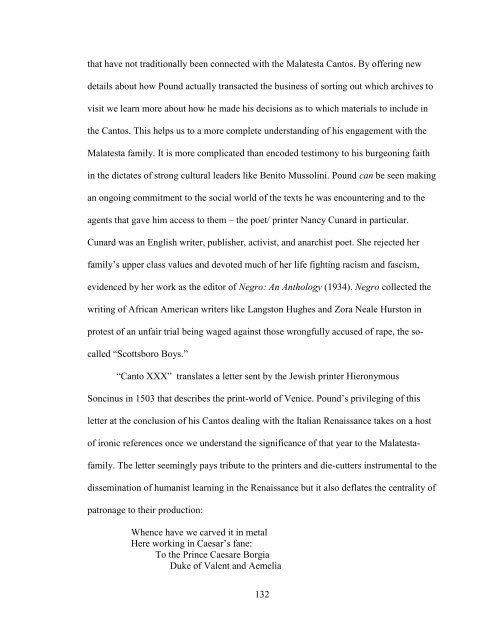TABOO: THE ACTUAL MODERNIST AESTHETIC, MADE REAL A ...
TABOO: THE ACTUAL MODERNIST AESTHETIC, MADE REAL A ...
TABOO: THE ACTUAL MODERNIST AESTHETIC, MADE REAL A ...
You also want an ePaper? Increase the reach of your titles
YUMPU automatically turns print PDFs into web optimized ePapers that Google loves.
that have not traditionally been connected with the Malatesta Cantos. By offering new<br />
details about how Pound actually transacted the business of sorting out which archives to<br />
visit we learn more about how he made his decisions as to which materials to include in<br />
the Cantos. This helps us to a more complete understanding of his engagement with the<br />
Malatesta family. It is more complicated than encoded testimony to his burgeoning faith<br />
in the dictates of strong cultural leaders like Benito Mussolini. Pound can be seen making<br />
an ongoing commitment to the social world of the texts he was encountering and to the<br />
agents that gave him access to them – the poet/ printer Nancy Cunard in particular.<br />
Cunard was an English writer, publisher, activist, and anarchist poet. She rejected her<br />
family‘s upper class values and devoted much of her life fighting racism and fascism,<br />
evidenced by her work as the editor of Negro: An Anthology (1934). Negro collected the<br />
writing of African American writers like Langston Hughes and Zora Neale Hurston in<br />
protest of an unfair trial being waged against those wrongfully accused of rape, the so-<br />
called ―Scottsboro Boys.‖<br />
―Canto XXX‖ translates a letter sent by the Jewish printer Hieronymous<br />
Soncinus in 1503 that describes the print-world of Venice. Pound‘s privileging of this<br />
letter at the conclusion of his Cantos dealing with the Italian Renaissance takes on a host<br />
of ironic references once we understand the significance of that year to the Malatesta-<br />
family. The letter seemingly pays tribute to the printers and die-cutters instrumental to the<br />
dissemination of humanist learning in the Renaissance but it also deflates the centrality of<br />
patronage to their production:<br />
Whence have we carved it in metal<br />
Here working in Caesar‘s fane:<br />
To the Prince Caesare Borgia<br />
Duke of Valent and Aemelia<br />
132
















